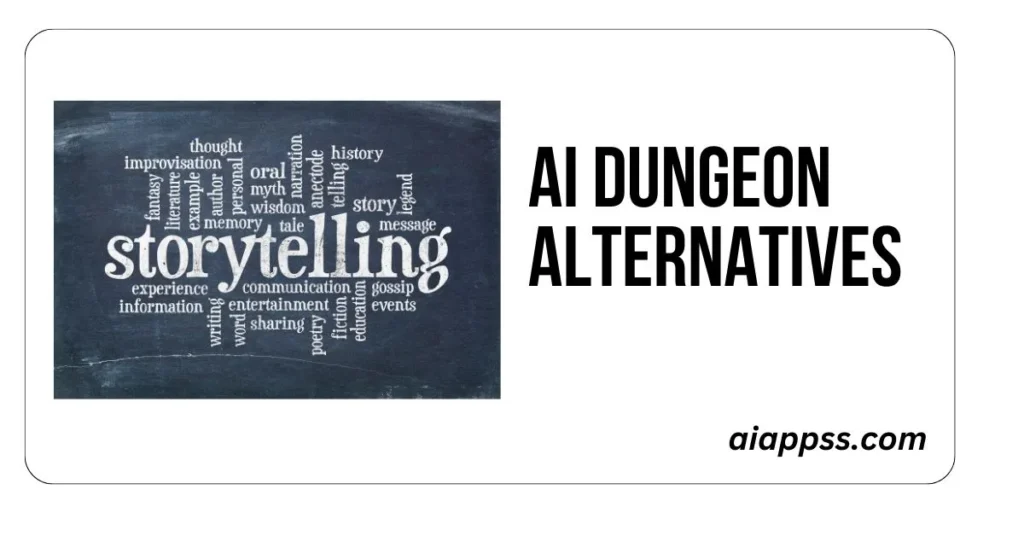You’re undoubtedly familiar with GPT-3 , if you’ve ever studied Artificial Intelligence (AI) or Natural Language Processing (NLP). What is GPT-3, how does it function, who created it, and what are its advantages?
We’ll cover all the information regarding GPT-3 in this blog article.
Ever since OpenAI published ChatGPT it generally become has used. It generates text that resembles human speech by foretelling the most probable word to appear next in a string of words using deep learning algorithms.
GPT 3 and GPT 4 is used for coding, creating amazing articles, and stories, making an outline of Youtube videos, translating texts, problem-solving, and songwriting, among other tasks, this OpenAI platform produces amazing results.
2023’s Top ChatGPT Alternatives (Free & Paid)
1. Google BERT
Natural language processing has made significant progress in recent years because of machine learning models like Google BERT (Bidirectional Encoder Representations from Transformers), which excel at comprehending human language.
BERT is a natural language processing method based on neural networks that aim to comprehend language more deeply than earlier models.
BERT is based on transformer architecture, which is a neural network made to handle sequential data like text. Unlike earlier models that processed text in a linear fashion, BERT is a bi-directional model that is able to look at the context of words before and after them in order to better understand the meaning of each word in a sentence.
The model is adjusted for certain natural language processing tasks after being pre-trained on a sizable corpus of text, such as Wikipedia or news articles.
Features of Google BERT
1. BERT (short for Bidirectional Encoder Representations from Transformers) is a bidirectional transformer model, which means it may analyze a word’s context in a sentence not just from left to right (as in standard language models), but also from right to left.
2. BERT is a pre-trained language model, which means it was trained on a large quantity of text data before being fine-tuned for specific natural language processing applications.
3. BERT generates contextualized word embeddings, which means that the representation of a word in a phrase can alter based on its context. BERT can now capture more subtle concepts and perform better on natural language understanding challenges.
4. BERT may be customized for a range of downstream natural language processing tasks, including text categorization, named entity identification, and question-answering. This enables BERT to use its pre-training to attain state-of-the-art performance on certain tasks with relatively little training data.
5. During pre-training, BERT utilizes a masked language modeling goal, where it randomly masks part of the tokens in a phrase and tries to predict them based on the surrounding context. This assists BERT in learning to represent words in a way that considers their connections with other words in a phrase.
BERT was created by Google’s research team and debuted in a paper in 2018.
BERT has now gained popularity as one of the most extensively used natural language processing models, finding use in a variety of fields.
Developers may utilize Google BERT for a range of natural language processing activities, including sentiment analysis, question-answering, and chatbot creation, thanks to the Google Cloud AI Platform, which makes the model available.
To make it simple for developers to get started with BERT, the platform also offers APIs and pre-built models for typical use cases.
2. Microsoft LUIS
A growing number of companies are turning to conversational AI as a tool to enhance customer service, boost productivity, and automate routine operations. Microsoft LUIS is one of the top conversational AI systems (Language Understanding Intelligent Service).
In this blog, we’ll take a closer look at what LUIS is, how it works, who made it, and what are its benefits.
Businesses may build natural language processing models for chatbots, virtual assistants, and other conversational interfaces using the cloud-based conversational AI platform LUIS. The platform is meant to assist organizations in rapidly and simply developing conversational AI solutions with little to no coding needed.
Machine learning algorithms that have been trained on massive text datasets are the foundation of LUIS. The software interprets natural language inputs using intent recognition and entity extraction to deliver precise answers to user questions.
Intent Recognition – Identification of the purpose behind a user’s input, such as making a reservation, placing a purchase, or requesting information, is known as intent recognition.
Entity extraction entails locating important data in user input, such as a product’s name or a reservation’s date.
LUIS can then learn to identify each purpose and entity in natural language inputs thanks to the example words they offer that correlate to each one.

Features of Microsoft LUIS
1. LUIS enables developers to describe the intentions of user input, that is, what the user is attempting to do or convey. This is an essential element for developing conversational AI apps since it enables the system to grasp the user’s intent and reply appropriately.
2. LUIS can also detect particular information in user input, such as names, dates, and places. This feature enables the system to take pertinent information from user input and utilize it to give a more tailored and relevant answer.
3. LUIS has a dialogue management capability that allows developers to establish the user-AI system interaction flow. This includes the ability to manage context switching and preserve context throughout numerous conversational turns.
4. LUIS allows developers to modify the natural language understanding model to their unique use case. This includes the ability to declare their own unique intents and entities, as well as train the model using their own data.
5. LUIS interfaces with other Microsoft services such as Azure Bot Service, Microsoft Teams, and Azure Cognitive Services, making it possible for developers to rapidly and simply design and deploy conversational AI applications.
Microsoft LUIS may be accessed via the Azure portal, which offers a web-based interface for creating and administering conversational AI models.
The LUIS API is a tool that developers may utilize to incorporate the platform into their own applications.
A potent tool for companies trying to develop conversational AI solutions is Microsoft LUIS.
LUIS is suitable for a variety of sectors and applications thanks to its simplicity, high accuracy, scalability, and customization possibilities.
Also Read – Best AI software for healthcare sector
3. ChatSonic
Conversational AI and chatbots have completely changed how companies communicate with their consumers. Yet, creating a top-notch chatbot may be difficult and time-consuming.
Businesses can rapidly and easily design and deploy chatbots using the cloud-based conversational AI platform ChatSonic. The platform’s goal is to streamline the chatbot creation process so that organisations may concentrate on providing excellent client conversational experiences.
A machine learning engine that has been trained on enormous datasets of conversational data forms the basis of ChatSonic.
The platform interprets user inputs using natural language processing (NLP) and intent recognition to deliver precise answers.
Developers begin by specifying the entities and intents that the chatbot will be able to detect when creating a chatbot in ChatSonic. After that, they offer example sentences for each purpose and entity so that ChatSonic may practice identifying them in inputs made using natural language.
Sonic Analytics, a machine learning, and artificial intelligence-focused technology business created ChatSonic. Since its founding in 2017, the business has grown to become one of the top suppliers of conversational AI solutions.
Developers may create and manage chatbots with the help of ChatSonic’s user-friendly web-based interface. The platform has a variety of features and tools, including a visual conversation builder, capability for multi-channel deployment, and natural language processing.
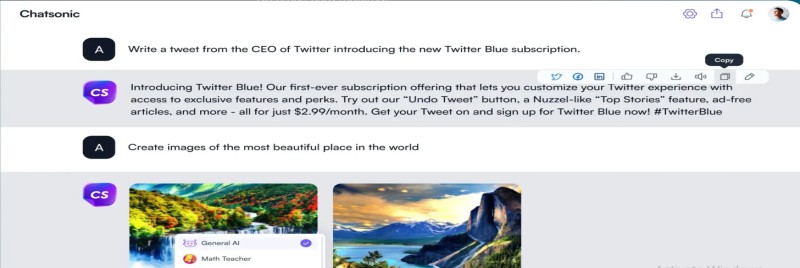
Features of Chatsonic
1. ChatSonic.ai uses natural language processing (NLP) technology to comprehend and analyse the purpose and meaning of user texts or voice inputs. This enables it to give consumers more accurate and customised replies.
2. ChatSonic.ai offers a variety of channels, including online chat, Facebook Messenger, WhatsApp, SMS, and voice assistants such as Amazon Alexa and Google Assistant. Businesses may now reach their clients on the channels they choose.
3. Chatbot and Voice Assistant Builder: ChatSonic.ai is a visual chatbot and voice assistant builder that allows organisations to design and configure their chatbots’ and voice assistants’ conversational flow and user experience. The builder also contains pre-built templates to assist enterprises in getting up and running quickly.
4. ChatSonic.ai has dialogue management features, allowing it to preserve context and handle complicated discussions with many intents and branching.
5. ChatSonic.ai offers sophisticated analytics and reporting services that allow organisations to track the effectiveness of their chatbots and voice assistants, such as user engagement, conversation flows, and sentiment analysis.
Developers can easily create and maintain chatbots using ChatSonic’s array of features and tools thanks to its user-friendly design.
With ChatSonic, businesses can easily contact their consumers wherever they are because of the variety of channels it supports, including online, mobile, messaging platforms, and voice assistants.
With ChatSonic, developers may design unique intents and entities to construct chatbots that are suited to their particular use cases.
ChatSonic is suitable for a wide range of industries and applications thanks to its simplicity, high accuracy, multi-channel deployment capabilities, and customization choices.
4. Microsoft Bing
Microsoft An internet search engine called Bing was introduced in 2009. With a market share of around 2.7% as of 2021, it is the second most used search engine in the world after Google.
Microsoft Corporation owns and runs Bing, which is accessible in over 40 languages.
In order to crawl the web and index material, Bing employs sophisticated algorithms. Relevance is determined by a number of variables, including keywords, geography, language, freshness, and popularity, according to Bing.
To aid customers in finding the information they want more quickly and simply, Bing also provides tools like spell check, auto-suggest, and fast responses.
A global technology business with headquarters in Redmond, Washington, Microsoft Corporation created Bing. In 1975, Bill Gates and Paul Allen created Microsoft, which has since grown into one of the greatest and most prosperous businesses in the world. Windows, Office, Xbox, and Surface are produced by Microsoft.
Features of Microsoft Bing
1. Bing provides web search results from a variety of sources, including websites, images, videos, and news articles. It leverages complex algorithms to give the most relevant results based on the user’s search query.
2. Intelligent Responses: Bing provides informative solutions to common search queries such as currency conversions, weather forecasts, and flight tracking. Users may further refine their inquiries by using features such as auto-complete and spell-check.
3. Personalization: Bing provides a number of personalization capabilities that allow users to adjust their search experience, including preferred languages and locales, secure search filters, and customised news feeds.
4. Bing has a visual search option that allows users to look for photos by uploading an image or using keywords. It can also identify items inside photos and return relevant search results.
5. Bing is connected with other Microsoft services such as Windows and Office. Users may now search for files and documents on their devices directly from the search bar.
Moreover, Bing provides capabilities like pictures, videos, news, and other types of searches.
A clutter- and distraction-free interface that is simple to use is provided by Bing. Bing further provides capabilities not seen on other search engines, such as the capacity to look for photographs depending on size and color, as well as the capacity to preview search results without leaving the search page.
Bing provides incentives through its Bing Rewards program, which enables users to accumulate points for using the search engine and exchange them for incentives like gift cards and charity contributions.
Bing can help you discover what you’re looking for quickly and effortlessly whether you’re looking for information, photographs, movies, news, or something else.
5. Jasper Chat
An AI-driven chatbot platform named Jasper Chat was created by a small company called Jasper Labs.
The platform is intended to assist companies in automating their customer support and service operations, enabling them to respond quickly and individually to the questions and concerns of their clients.
Jasper Chat uses Machine Learning Techniques and Natural Language Processing (NLP) to comprehend and instantly answer to client inquiries.
When a consumer starts a chat session, Jasper Chat analyses the message to ascertain the message’s context and intent using its NLP capabilities.
Jasper Labs, a 2018-founded firm with offices in San Francisco, created Jasper Chat. The company’s goal is to provide companies with AI-powered chatbots that can enhance their customer support and operational processes.
Leading VC companies including Sequoia Capital, General Catalyst, and Khosla Ventures support Jasper Labs, which has garnered over $15 million in financing so far.
On the Jasper Labs website, businesses may register for the platform and build their chatbot using a straightforward drag-and-drop interface.
Customers will be able to start chat sessions with the chatbot once they have integrated it with their website or mobile app.
Features of Jasper Chat
1. Jasper.ai employs cutting-edge NLP algorithms to identify the intent of user communications and voice inputs. This enables it to respond to user inquiries with precision and relevance.
2. Jasper.ai has contextual understanding capabilities that let it keep context during many conversational turns. This enables it to respond to people in a more tailored and pertinent manner.
3. Jasper.ai offers support for a variety of channels, including online chat, Facebook Messenger, WhatsApp, SMS, and voice assistants like Google Assistant and Amazon Alexa. This makes it possible for companies to connect with clients on the platforms they like.
4. With the great degree of customization that Jasper.ai provides, businesses may modify the natural language understanding model to fit their particular use case. In order to train the model and describe certain intents and entities, they can also utilise their own data.
5. Dialog management: Jasper.ai’s dialogue management features enable it to control conversations with a variety of branching and intents. The ability to control context switching and maintain context throughout several conversational turns falls under this category.
Jasper Chat also provides a variety of customization choices, enabling companies to modify the chatbot’s replies to suit their own requirements.
Using Jasper Chat for commercial purposes has a number of advantages. Jasper Chat, for instance, may assist companies in lowering the cost of providing customer care by automating basic questions and assistance requests. This enables customer support agents to concentrate on more challenging problems that need human assistance.
Moreover, Jasper Chat may give companies insightful information on the tastes and behavior of their clients, enabling them to better cater their goods and services to their demands. By offering prompt and individualized solutions to their customers’ questions and concerns, Jasper Chat may also assist organisations in raising customer satisfaction levels.
6. Character AI
Developers may design and include intelligent virtual characters in their apps using Character AI, an AI-powered platform. These computerized people may have real-world conversations with users and engage them in interesting ways, making the experience more realistic and unique.
In order to develop virtual characters that can comprehend and respond to users in real time, Character AI combines natural language processing (NLP), machine learning, and computer vision techniques. Using the platform, programmers can create and modify virtual characters with a straightforward drag-and-drop interface and then incorporate those characters into their apps utilising a number of SDKs and APIs.
Character AI was created by Quantum Capture, a Toronto-based business formed in 2015.
The goal of the business is to give programmers the resources they need to make intelligent virtual characters that can improve user experience in a variety of applications.
Leading businesses in sectors including gaming, entertainment, and retail have partnered with Quantum Capture, which has also received several honors for its cutting-edge technology.
It’s simple to use Character AI.
On the Quantum Capture website, developers may register for the platform and use the drag-and-drop interface to construct their virtual avatars. Depending on the platform they are creating for, they can then include these characters into their apps utilizing a number of SDKs and APIs.
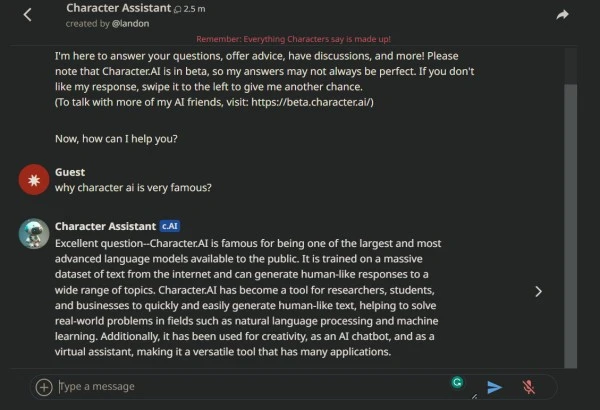
Features of Charactter AI
Features of Character AI
1. Emotional Intelligence: Chatbots and voice assistants can identify and react to user emotions thanks to emotional intelligence elements that are part of character AI. This involves the capacity to discern tone and emotion and change the conversational approach accordingly.
2. Character AI lets companies give their chatbots or voice assistants a distinctive personality. This includes attributes like tone, voice, and conversational style that may be altered to suit the tone and voice of the brand.
3. Character AI makes use of cutting-edge natural language processing (NLP) techniques to comprehend and decipher the purpose and meaning of user texts or voice inputs. This enables it to respond to consumers more precisely and individually.
4. Compatibility for Many Channels: Character AI is compatible with a number of channels, including online chat, Facebook Messenger, WhatsApp, SMS, and voice assistants like Google Assistant and Amazon Alexa. This makes it possible for companies to connect with clients on the platforms they like.
5. Dialog Management: Character AI is equipped with dialogue management tools that let it keep the dialogue in context and handle conversations with many different branches and intentions.
Character AI also provides a number of customization possibilities, enabling creators to modify virtual characters to suit their own requirements.
For developers, employing character AI has a number of advantages. For starters, the platform enables developers to design interactive, individualized user interfaces that can raise the general standard of their apps.
Virtual characters may aid users by answering their queries, giving them useful information, and guiding them through difficult tasks in a more natural and user-friendly way. Also, by automating repetitive operations and queries, virtual characters can save up developers’ time and resources so they can work on more difficult problems.
7. YouChat
A platform powered by AI called YouChat ai enables companies to build and incorporate smart chatbots into their messaging platforms. These chatbots may assist organizations in automating regular chores and queries while also giving their consumers a more tailored and interesting experience.
To build chatbots that can comprehend and reply to clients in real-time, YouChat ai combines natural language processing (NLP), machine learning, and computer vision technologies. With a straightforward drag-and-drop interface, the platform enables organizations to create and configure chatbots. They can then use a range of SDKs and APIs to connect these chatbots to their messaging services.
YouChat, a San Francisco-based firm established in 2016, created YouChat ai. The company’s goal is to give organizations the resources they need to build intelligent chatbots that can boost customer satisfaction and operational effectiveness. Leading venture capital companies like Andreessen Horowitz and Greylock Partners support YouChat, which has garnered over $20 million in investment to date.
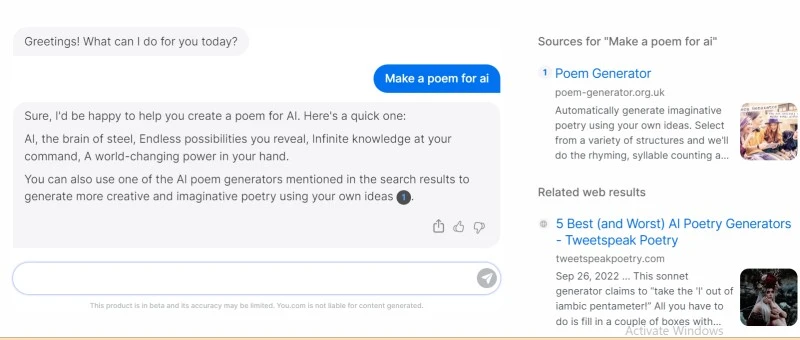
Features of Youchat
1. Users of You.com may manage their digital lives with the aid of a customized AI helper. The AI assistant is capable of handling duties including making suggestions based on the user’s preferences, delivering messages, and organizing appointments.
2. You.com strongly emphasizes data privacy and ownership, giving consumers control over their data and its usage. To keep user data secure, the platform employs end-to-end encryption.
3. You.com has the ability to link with various platforms and services, like social networking, email, and chat programs, to offer a seamless online experience.
4. The artificial intelligence (AI) assistant on You.com employs natural language processing (NLP) to comprehend user queries and provide conversational responses.
5. Users may access their customized AI helper wherever they are thanks to You.com’s mobile apps for both iOS and Android smartphones.
Businesses may also customize their chatbots with a variety of customization options provided by YouChatto to meet their unique demands.
By automating mundane operations and inquiries, the platform enables organizations to free up their staff’s time and resources so they can concentrate on more difficult problems.
Moreover, chatbots may provide clients with a more customized and interesting experience, enhancing client loyalty and happiness. Lastly, chatbots may assist companies in learning important details about the tastes and behavior of their clients, helping them to better comprehend their target market and enhance their goods and services.
Also Read – These DND AI art Generators are amazing
8. DeepL Write
DeepL, a renowned German AI research firm, has created DeepL Write, an AI-driven writing aid application. With the use of deep learning algorithms and natural language processing (NLP), this technology enables authors to create error-free, high-quality material.
DeepL Write works by instantly evaluating the text you are writing and making suggestions for enhancements and errors. This contains advice on proper grammar and syntax as well as suggestions for better verb tenses and sentence constructions. In order to provide more tailored and precise suggestions when the user uses the tool more frequently, DeepL Write is also built to learn from the user’s writing style over time.
German-based DeepL is a top AI research organization with a focus on machine translation and natural language processing.
A group of seasoned academics and engineers formed the business in 2017 with the goal of developing AI-powered solutions that help enhance human comprehension and communication. The DeepL Translator, a well-known machine translation tool, and DeepL Pro, a collection of sophisticated translation and language tools for organizations, are among DeepL’s offerings.
It’s easy and simple to use DeepL Write. The tool is available on the DeepL website and through the DeepL Write plugin for widely used word processors like Google Docs and Microsoft Word.
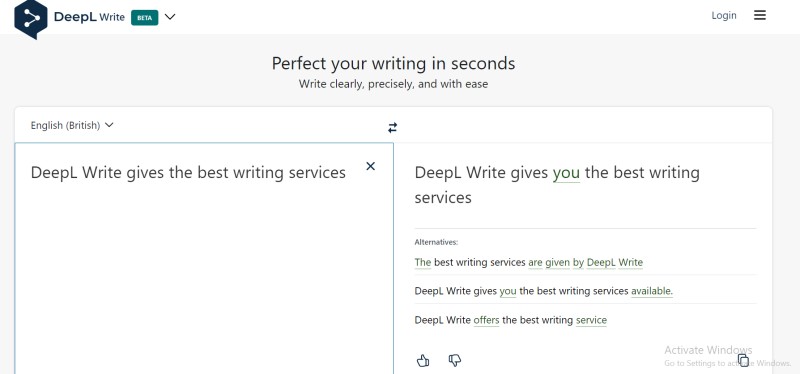
Features of DeepL write
1. DeepL is renowned for producing excellent translations that accurately convey the intricacies of the original language while sounding natural.
2. English, German, French, Spanish, Italian, Portuguese, Dutch, Polish, Russian, Japanese, and Chinese are among the languages that DeepL provides translations between.
3 . Fast, producing translations in only a few seconds, is the goal of DeepL’s translation engine.
4. The document translation service provided by DeepL enables customers to submit and translate whole documents at once. Those who need to translate a lot of text may find this option to be time-saving.
5. The DeepL API, which can be incorporated into other programs and services, also gives users access to the translation engine.
The program can assist authors in creating better-quality content that is devoid of grammatical and syntactic mistakes, increasing the readability and impact of their work.
DeepL Write may also assist authors in improving their vocabulary and sentence structure so they can interact with their target audience more successfully.
Last but not least, DeepL Write is built to learn from the user’s writing style over time, enabling it to provide more accurate and tailored suggestions as the user uses the tool.
An effective AI-powered writing aid called DeepL Write may assist authors in creating high-quality content that is free of grammatical and syntactic mistakes.
9. Rytr
Rytr is a writing helper tool with AI that makes it simple and quick for users to produce high-quality material.
It produces excellent text from user input using natural language processing (NLP) and machine learning methods. Rytr works by evaluating the user’s input and creating text based on that information. Users may enter a subject or concept, and Rytr will produce writing in response.
The text may then be modified by users as required, and Rytr will keep producing new text depending on those modifications. The program also provides recommendations for various writing forms, tones, and styles, enabling users to adapt their material to suit their particular requirements.
In the year 2020, Abhishek Sharma and Navid Hadzaad established Rytr.
The business, which has its headquarters in San Francisco, California, has grown rapidly in recognition among marketers and content producers. It’s simple and straightforward to use Rytr.
By visiting the Rytr website or installing the Rytr plugin for widely used word processors like Google Documents and Microsoft Word, users may use the tool.
Users may enter a topic or concept and choose the writing style and tone they want the material to be written in after the software has been installed.
Rytr will then produce text based on those inputs, which users may subsequently amend and improve as necessary. Also, users have the option to export the content in a number of other forms, such as HTML, PDF, and plain text.
Features of Rytr
1. Rytr employs cutting-edge Natural Language Processing (NLP) algorithms to evaluate and comprehend text inputs and create high-quality written content based on user needs.
2. Rytr may assist customers in creating a variety of written material, such as landing pages, emails, social media postings, and blog articles. Customers may specify detailed instructions and standards for the material they need, and Rytr will produce excellent language that complies with their specifications.
3. Rytr users may alter the tone, style, and voice of the material they create to better suit their brands or individual tastes. Users may personalize the output to fit their individual voice by selecting from a variety of writing styles and tones.
4. Rytr provides tools for teamwork that let users work together on the same content project. Users may ask coworkers to join a project, and Rytr will assist them in producing material that satisfies their common objectives.
5. Rytr offers seamless integration with a variety of other programs and services, such as content management systems, project management tools, and others. This enables integrating Rytr’s writing capabilities into current workflows simple.
The tool can generate high-quality material fast and simply, saving users time and effort. Rytr further offers users a jumping-off point for their content production, which might assist users in getting over writer’s block.
The program also provides recommendations for various writing tenors and styles, enabling users to adapt their material to suit their particular requirements.
Rytr is built to learn from the input and revisions of the user, enabling it to produce more accurate and customized content over time. Rytr is a potent writing helper driven by AI that can aid marketers and content creators in producing high-quality material swiftly and simply.
With its cutting-edge machine learning and natural language processing techniques, Users may save time and effort while still creating high-quality content with Rytr’s tailored and accurate text production ideas.
10. HyperWrite
The writing tool HyperWrite was created by Hyper.ai, a firm that aims to employ AI to increase writing productivity and accuracy. By employing AI to propose words, sentences, and even complete paragraphs based on the context and subject of the writing, the application is intended to assist authors in producing material more quickly and with fewer errors.
HyperWrite analyses the text being written using machine learning algorithms to produce ideas for how to make it better. It is simple for authors to access and utilize the tool since it can be linked to well-known word-processing tools like Microsoft Word and Google Docs.
Hyper ai, a firm launched in 2019 by a group of AI experts and software engineers, created HyperWrite. The company’s main goal is to apply AI to boost output and effectiveness across a range of sectors, including writing and content production.
Using HyperWrite is very simple.
With a quick plugin or extension installation, the application may be incorporated into well-known word-processing tools like Microsoft Word and Google Docs. When the program has been installed, authors may activate it and start writing as normal.
Features of HyperWrite
1. Writing aid: HyperWrite.ai might give real-time writing assistance by delivering ideas for sentence structure, word choice, and grammar.
2. HyperWrite.ai may help you write more effectively for search engines by suggesting appropriate keywords for your material.
3. HyperWrite.ai can assist you with content planning by making ideas, themes, and outlines depending on your target audience and objectives.
4. Users of HyperWrite.ai may be able to alter the tone and style of their writing to better reflect their brands or personalities.
5. Content analysis: HyperWrite.ai might evaluate already-published material and offer edits to raise readability, interest, and overall quality.
HyperWrite will evaluate the content and make suggestions for enhancements. The writer has ultimate control over the outcome and may choose to accept or reject these ideas.
HyperWrite can help writers generate content faster by suggesting improvements in real-time, reducing the time needed for editing and revision.
HyperWrite can catch spelling and grammar errors that might otherwise go unnoticed, improving the accuracy and quality of the writing.
This AI tool can make suggestions for changes to the tone, style, and general structure. HyperWrite is undoubtedly worthwhile checking out whether you are a professional writer or just someone who wants to enhance your writing abilities.

